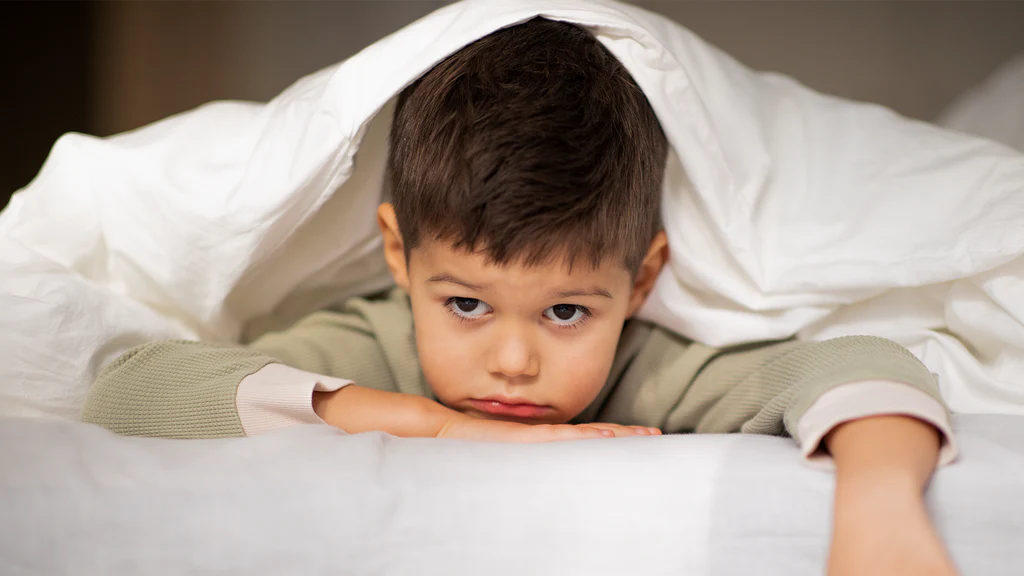Understanding and Addressing Childhood Sleep Problems
Understanding and Addressing Childhood Sleep Problems
Sleep is essential for children’s growth, development, and overall well-being. However, many children experience sleep problems that can disrupt their sleep patterns and impact their physical and emotional health. From bedtime struggles to frequent night waking, understanding the underlying causes of childhood sleep problems is crucial for effective intervention and support. In this article, we’ll explore common childhood sleep issues, their potential causes, and practical strategies for addressing them.

Common Childhood Sleep Problems
- Difficulty Falling Asleep: Some children struggle to fall asleep at bedtime, often experiencing restlessness, tossing, and turning, or prolonged periods of wakefulness before finally drifting off to sleep.
- Night Wakings: Many children experience night waking, where they awaken multiple times during the night and have difficulty returning to sleep independently. Night wakings can disrupt both children’s sleep and their parents’ rest.
- Nightmares and Night Terrors: Nightmares are vivid and frightening dreams that awaken children from sleep, often leaving them feeling scared or anxious. Night terrors, on the other hand, are episodes of intense fear or agitation that occur during deep sleep, typically within the first few hours after falling asleep.
- Bedtime Resistance: Some children resist bedtime, expressing reluctance or refusal to go to bed at the designated time. Bedtime resistance may manifest as tantrums, protests, or attempts to delay sleep through various tactics.
- Sleepwalking and Sleep Talking: Sleepwalking involves walking or performing other complex behaviors while asleep, typically during the deeper stages of non-REM sleep. Sleep talking, or somniloquy, refers to talking or mumbling during sleep without full awareness.
Understanding the Causes
Childhood sleep problems can have various underlying causes, including:
- Developmental Milestones: Children’s sleep patterns can be influenced by developmental milestones such as teething, growth spurts, and cognitive or emotional changes.
- Environmental Factors: Factors such as noise, light, temperature, and disruptions to the sleep environment can impact children’s sleep quality and duration.
- Routine Changes: Changes in routine, such as travel, starting school, or transitioning to a new caregiver, can disrupt children’s sleep patterns and contribute to sleep problems.
- Stress and Anxiety: Stressful life events, separation anxiety, or fears and worries can interfere with children’s ability to relax and fall asleep peacefully.
- Medical Conditions: Certain medical conditions, such as sleep disorders, allergies, asthma, or gastrointestinal issues, may contribute to sleep disturbances in children.
Addressing Childhood Sleep Problems
- Establish a Consistent Bedtime Routine: Create a calming bedtime routine that helps signal to your child that it’s time to wind down and prepare for sleep. Activities such as reading a book, taking a warm bath, or practicing relaxation techniques can promote relaxation and sleepiness.
- Create a Sleep-Conducive Environment: Ensure that your child’s sleep environment is comfortable, quiet, and conducive to sleep. Keep the bedroom dark, cool, and free from distractions such as screens or electronic devices.
- Maintain Consistent Sleep Schedule: Stick to a consistent sleep schedule, with regular bedtime and wake-up times, even on weekends or during holidays. Consistency helps regulate children’s internal body clocks and promotes healthy sleep patterns.
- Address Underlying Concerns: If your child’s sleep problems persist despite efforts to establish healthy sleep habits, consult with a pediatrician or sleep specialist to rule out any underlying medical or psychological concerns.
- Encourage Daytime Physical Activity: Engage your child in regular physical activity during the day, as exercise can promote better sleep quality and duration. However, avoid vigorous exercise close to bedtime, as it may interfere with sleep.
- Limit Screen Time Before Bed: Minimize exposure to screens, including TVs, computers, tablets, and smartphones, in the hour leading up to bedtime. The blue light emitted by screens can disrupt the production of melatonin, a hormone that regulates sleep-wake cycles.
- Practice Positive Sleep Associations: Encourage positive sleep associations by associating bedtime with comforting and soothing experiences. Offer a favorite stuffed animal, blanket, or bedtime story to help your child feel secure and relaxed.
- Promote Healthy Sleep Hygiene: Teach your child the importance of practicing good sleep hygiene, such as avoiding caffeine, establishing a relaxing bedtime routine, and creating a sleep-friendly environment.
- Provide Emotional Support: Address any underlying fears, worries, or anxieties that may be contributing to your child’s sleep problems. Offer reassurance, validation, and emotional support to help your child feel safe and secure at bedtime.
- Be Patient and Consistent: Addressing childhood sleep problems may require patience, consistency, and persistence. Be patient with your child as they adjust to new sleep habits, and remain consistent in your approach to promoting healthy sleep.
Conclusion
Childhood sleep problems are common but manageable with the right approach and support. By understanding the underlying causes of sleep disturbances and implementing practical strategies to promote healthy sleep habits, parents can help their children enjoy restful and rejuvenating sleep. Prioritize your child’s sleep health, and seek professional guidance if sleep problems persist or worsen over time. With patience, consistency, and care, you can help your child develop lifelong sleep habits that support their overall well-being and development.
This post is also available in: Français (French)